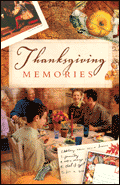Thanksgiving Memories
[ English | Vietnamese ]
 Short Description: Thanksgiving is about more than watching football and eating turkey. It's a
time to reflect on God's provision in our lives and throughout history. This
tract encourages readers to make meaningful Thanksgiving memories and provides
space to record them for the future.
Short Description: Thanksgiving is about more than watching football and eating turkey. It's a
time to reflect on God's provision in our lives and throughout history. This
tract encourages readers to make meaningful Thanksgiving memories and provides
space to record them for the future.
In our home on Thanksgiving, everyone’s place at the table is set with five kernels of corn, a card, and a pen. The kernels of corn are a reminder to us of the meager rations the Pilgrims lived on during their first three years in Plymouth. After we read the Pilgrims’ story, everyone shares five things he or she is grateful for during the past year. We then hold hands and offer a prayer of gratitude to God for His abundant blessings and for the ways we have seen Him at work in our lives.
Reviewing what God has done in our lives is healthy, and it is biblical. Psalm 105:5 tells us to “remember his marvelous works that he hath done; his wonders, and the judgments of his mouth.”
May we resolve to be a grateful people in this nation, and may we not forget what God has done and what those who have gone before have sacrificed for us.
The First Thanksgiving
In September of 1620, a small wooden ship called the Mayflower set sail from England, headed for the New World. Crowded on board were 102 passengers, most of them Christians who believed that God was leading them to establish a new community where they could worship freely. After sixty-five days of tossing on the sea through ferocious storms, seasickness, terrible food, and no sanitation, these Pilgrims arrived on the shores of the New World.
Winter was setting in, and though they worked hard, they could not build their dwellings quickly enough. As the weeks went by, the weather grew worse. In the coldest stretch of winter, a flu-like illness swept through the colony. By the end of March, nearly half of those who had arrived on the Mayflower had died.
With the help of two English-speaking Indians, Samoset and Squanto, the remaining colonists formed a peace pact with the nearby Wampanoag tribe. Squanto also taught the settlers how to grow new crops, such as corn and pumpkins, and to trap beaver for their pelts.
By October 1621, the crops were ready for harvest. The Pilgrims’ hearts were full of gratitude for their renewed health, for the abundant harvest, and for the peace they enjoyed with the Indians. William Bradford, the new governor, declared that Plymouth should hold a thanksgiving festival and invite the settlement’s Indian friends as special guests. A date was set, and an invitation delivered to Chief Massasoit.
To make sure there was adequate food, the Pilgrim men went hunting and fishing. When Massasoit arrived with ninety hungry braves, they too went to the woods and seashore to gather food. When it was time to eat, the menu was impressive: venison, goose, lobster and other seafood, vegetables, and dried fruits. A special treat was supplied by the Indians. They placed corn on hot coals, and the kernels blew into white puffs—popcorn!
But before they began to eat, the Pilgrims offered a prayer to the God who had so clearly and miraculously led them to this place. Though they had suffered much, God had blessed them abundantly, and they sincerely offered Him their thanks and praise.
I'm Thankful For:
- ____________
- ____________
- ____________
- ____________
- ____________
Photos and text adapted from Thanksgiving: A Time to Remember by Barbara Rainey. © 2002. Published by Crossway Books.
© 2002 Good News Publishers. Used by permission.
Translated by permission of Good News Publishers
1300 Crescent Street
Wheaton, IL 60187
U.S.A.